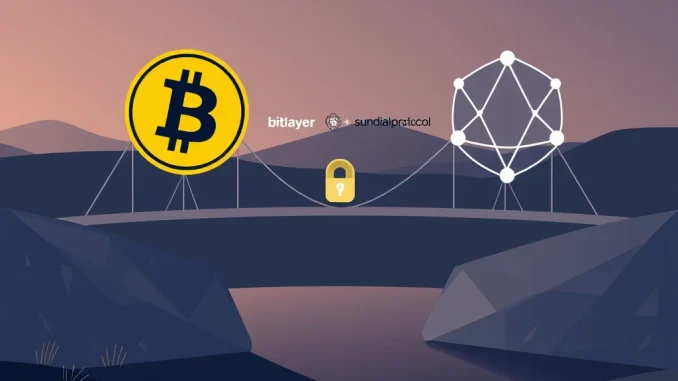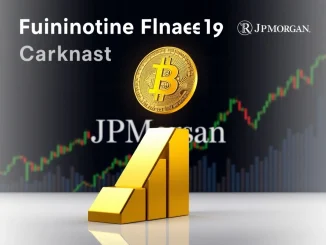
The cryptocurrency world thrives on connectivity and expanding possibilities. A significant development is underway as a new Bitcoin bridge is set to connect the largest cryptocurrency by market cap, Bitcoin (BTC), with the Cardano blockchain. This initiative, announced by the Bitcoin bridge layer-2 (L2) platform Bitlayer, involves a partnership with fellow L2 solution Sundial Protocol.
Bitlayer and Sundial Protocol Join Forces
In a recent announcement shared via their official X account, the Bitlayer team revealed the collaboration with Sundial Protocol. The core objective is ambitious yet straightforward: to construct a bridge enabling the seamless transfer of Bitcoin assets onto the Cardano network. This isn’t just any bridge; it’s planned to utilize BitVM technology, a promising approach for executing complex operations on Bitcoin.
This partnership brings together expertise from different corners of the L2 landscape, specifically focused on enhancing the utility and reach of Bitcoin and Cardano respectively.
Why Build a Bitcoin Bridge to Cardano?
The primary motivation behind creating a Bitcoin bridge to Cardano is to unlock liquidity and foster new use cases for BTC holders within the Cardano ecosystem. Currently, Bitcoin largely operates as a store of value on its native chain, with limited direct interaction with the burgeoning decentralized finance (DeFi) and application layers on other blockchains like Cardano.
Key benefits anticipated from this bridge include:
- Increased Liquidity: Bringing BTC onto Cardano can significantly boost the total value locked (TVL) and liquidity available for DeFi protocols, marketplaces, and other dApps on Cardano.
- New Opportunities for BTC Holders: Bitcoin holders will gain the ability to participate in Cardano-based activities such as lending, borrowing, staking (via wrapped BTC representations), and trading without needing to sell their BTC.
- Empowering Cardano Developers: Developers building on Cardano will have access to BTC-backed assets, enabling them to create innovative applications that leverage the value and trust associated with Bitcoin.
- Enhanced Interoperability: This bridge represents a step towards a more connected blockchain ecosystem, allowing value and functionality to flow more freely between two major networks.
Understanding the Role of BitVM
The partnership specifies the use of BitVM technology for the bridge. BitVM (Bitcoin Virtual Machine) is a concept that aims to enable complex computations and smart contract-like functionality on Bitcoin without altering Bitcoin‘s core protocol rules. It achieves this by using off-chain computation and on-chain verification via Taproot and other Bitcoin script enhancements.
For a Bitcoin bridge, BitVM is crucial for creating a trust-minimized or trustless mechanism. Instead of relying on a centralized third party or a multi-sig committee (which introduce points of failure or trust assumptions), a BitVM-based bridge could potentially use cryptographic proofs and challenges to ensure that wrapped BTC on Cardano is genuinely backed by locked BTC on the Bitcoin chain.
The implementation details are complex, involving commitments, proofs, and potential challenge periods, but the promise is a more secure and decentralized way to move value across chains compared to some earlier bridge designs.
The Players: Bitlayer and Sundial Protocol
Bitlayer positions itself as a Bitcoin layer-2 solution focused on enhancing scalability and programmability for Bitcoin. Their goal is to build an ecosystem where developers can create applications that interact with Bitcoin‘s security and liquidity.
Sundial Protocol is also an L2 solution, though its specific focus areas within the L2 space might differ or complement Bitlayer‘s. Their collaboration on this bridge suggests a shared vision for increasing cross-chain functionality and leveraging the strengths of different networks.
By combining their expertise, Bitlayer and Sundial Protocol aim to overcome the technical hurdles involved in building a robust and secure Bitcoin bridge to a UTXO-based chain like Cardano, utilizing the potential of BitVM.
Potential Impact and Challenges Ahead
If successful, this Bitcoin bridge could significantly impact both the Bitcoin and Cardano ecosystems. For Cardano, it could be a major catalyst for growth in its DeFi and dApp landscape by tapping into Bitcoin‘s vast market cap. For Bitcoin, it could provide new avenues for utility beyond just being a store of value, allowing holders to earn yield or participate in decentralized applications on Cardano.
However, building cross-chain bridges is notoriously difficult and comes with significant risks. Security is paramount, as bridges have historically been targets for exploits. The complexity of implementing BitVM and ensuring its security in practice is a major undertaking. User adoption will also be key; convincing Bitcoin holders to wrap their assets and use them on Cardano requires a secure, user-friendly, and valuable proposition.
Conclusion: A Promising Step for Cross-Chain Connectivity
The partnership between Bitlayer and Sundial Protocol to build a BitVM-based Bitcoin bridge to Cardano is a highly promising development for the interoperability of the blockchain space. By aiming to connect the liquidity of Bitcoin with the growing ecosystem of Cardano, they are working towards unlocking new possibilities for users and developers on both networks. While challenges remain in the complex process of bridge development and security, this initiative represents a significant step forward in making the crypto world more connected and functional.



